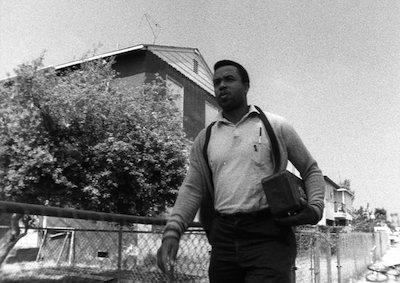Access every screening in the UCLA Festival of Preservation with a $50 pass.
The Savages (1967)
Restoration funding provided by the National Film Preservation Foundation.
Dubbed “Ghost Town” in 1967, the area of West Venice was then an impoverished African American community. Los Angeles native and UCLA film student, Alan Gorg set out to capture the lives of its inhabitants in their own words. Without adding his own commentary, he allowed the subjects to express themselves, from the hardworking man with his young family, to the jobless youth who seek temporary release from their circumstances through drink and parties.
Gorg aimed to give representation to African Americans, who due to housing and employment segregation, were rarely seen by white Los Angeles. The short begins with the voice-over of a white man discussing the savagery of African Americans. But we find it is not the people that are savage, but the harsh urban conditions. Opportunities are denied through systemic injustice and inequalities.
The Savages can be seen as a companion piece to Gorg’s earlier film, Felicia (1965), which was named to the National Film Registry by the Library of Congress in 2014.—Jillian Borders
35mm b/w, 25 min. Producer: Alan Gorg. Director: Alan Gorg. Cinematographer: Alan Gorg, Kit Grey, Ivan Craig, Joe Hanwright. With: the Youth of West Venice. Narrator: Robert Castle. In cooperation with Project Action Venice, California.
Preserved by UCLA Film & Television Archive from the 16mm original camera negative, 16mm A/B positive rolls and 16mm track positive. Laboratory services by The Stanford Theatre Film Laboratory, Audio Mechanics, Simon Daniel Sound, DJ Audio, Inc. Special thanks to Alan Gorg, Marsha Gordon, Mark Quigley.
Operation Bootstrap (1968)
Operation Bootstrap, a non-profit community-based organization, was founded in October 1965, just two months after the Watts rebellion, as a response to a neighborhood in distress. The brainchild of civil rights activists Robert Hall and Louis Smith, the two men were determined to facilitate social and economic change through community engagement and individual empowerment in this poverty stricken South Los Angeles neighborhood. The organization refashioned the rebellion’s chant of “Burn, Baby, Burn” to fit the community center’s mantra: “Learn, Baby, Learn” and “Earn, Baby, Earn.” The 1968 documentary captures Bootstrap’s mission of economic development with scenes of women and men training for a range of employment opportunities including how to operate power sewing machines for work in the local garment factory, to the new technologies of the day, the IBM keypunch machines. Especially engaging are the scenes of “sensitivity sessions” hosted by the organization, where black and white Angelenos debate issues of race and racism in 1960s America. The film’s cinéma-vérité style allows for a certain closeness with its subject and allows for a precious time capsule glimpse into this vibrant and struggling community. While the documentary is a celebration of late-1960s Watts and the community’s promise of economic revitalization driven by its residents and like-minded activists, the filmmakers never shy away from the toll that historical and systematic racism, its violence and utter disregard for humanity, has had on Black America.
Husband and wife filmmakers, Charles Carey and Altina Schinasi Carey, had previously made the Academy Award-nominated short documentary George Grosz’ Interregnum (1960) and had begun filming Dr. Martin Luther King, Jr. for a project that was never completed. Charles was a political scientist who would work for the RAND Corporation and Altina, from the Schinasi tobacco family fortune, in addition to inventing the Harlequin “cat-eye” glasses in the late 1930s, was a renowned visual artist.—Maya Montañez Smukler
DCP, b/w, 58 min. Distribution: Educational Communications Inc. Producer: Charles Carey, Altina Carey. Director: Charles Carey. Screenwriter: Charles Carey. Cinematographer: James Bryant. Editor: Alex Van Der Kar, Altina Carey. Cast: Robert Hall, Louis Smith, Dorothy Moore.
Picture and audio preserved by UCLA Film & Television Archive from the culmination of the two best 16mm b/w prints known. Laboratory services and DCP by UCLA Film & Television Archive, Digital Media Lab.






 Mobile Navigation
Mobile Navigation

